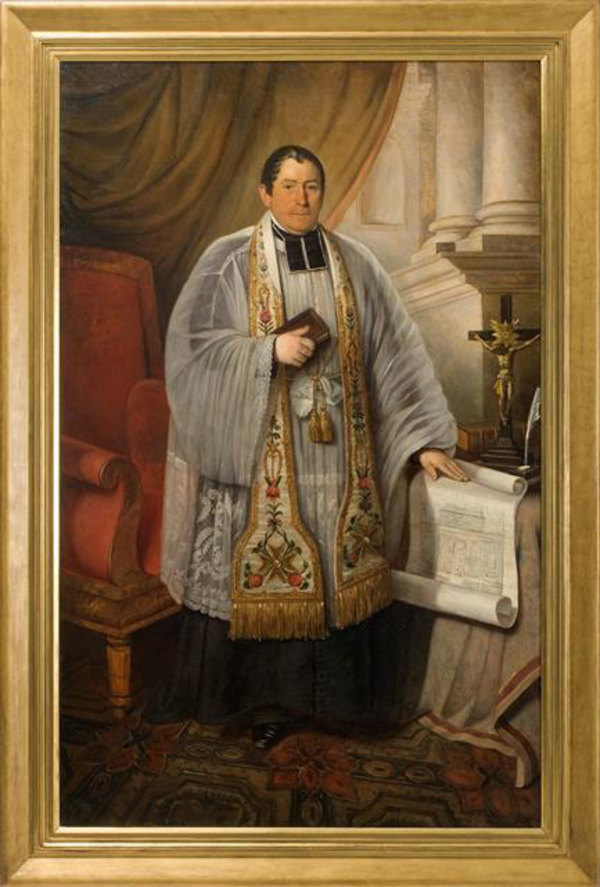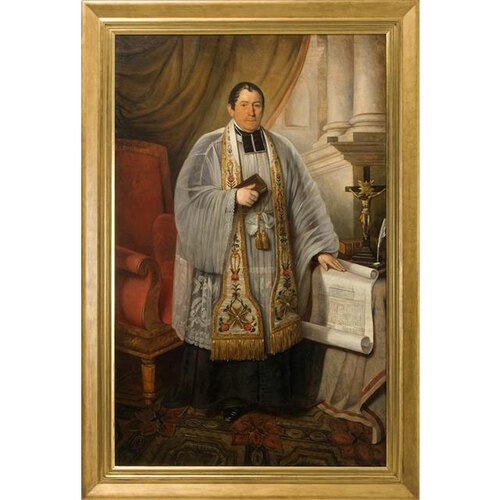
Source: Link
McMAHON, PATRICK, Roman Catholic priest; b. 24 Aug. 1796, probably in Abbeyleix (Republic of Ireland), son of Patrick McMahon and Winifred Kelly; d. 3 Oct. 1851 at Quebec.
Patrick McMahon completed classical studies in Ireland, probably at St Patrick’s College, Carlow, and around 1817 immigrated to Lower Canada with a large family group. By October of that year he had begun teaching English at the Collège de Saint-Hyacinthe, where he also studied for the priesthood and probably learned some French. Ordained in the cathedral of Notre-Dame at Quebec on 6 Oct. 1822, he was appointed curate there to serve the growing English-speaking, predominantly Irish, portion of the parish. On 25 May 1825 he was transferred to the mission at Saint John, N.B. Popular tradition suggests that he was sent there as punishment for his outspokenness, although no documentary evidence has been uncovered to support this conjecture. Despite his precarious health while in New Brunswick, he acquired a reputation for zeal and won the praise and admiration of his congregation.
By the time McMahon returned to Quebec in 1828 to resume his functions at Notre-Dame, Irish Catholic laymen, with Father Hugh Paisley as their curate, had taken the first steps towards obtaining a church of their own. John Cannon*, Gordian Horan, and Michael Quigley had formed the nucleus of a management committee of the “Catholics of Quebec Speaking the English Language” which had begun negotiations in 1827 with the trustees of the fabrique of Notre-Dame. Under McMahon, the discussions continued and construction of the new church, designed by architect Thomas Baillairgé, began in 1831. On 7 July 1833 McMahon and the Irish Catholics rejoiced at the first mass in St Patrick’s Church on Rue Sainte-Hélène (later named Rue McMahon in his honour). For the next 18 years McMahon, occasionally with the help of an assistant, ministered to that church, a succursal of Notre-Dame; by 1835 it served approximately 6,000 people.
During the 1830s and 1840s the port of Quebec received thousands of immigrants from the British Isles, most of them Irish Catholic. As a member of the executive of the Quebec Emigrant Society, McMahon worked closely with the emigration agent of the port, Alexander Carlisle Buchanan, and appeared with him before a committee of the House of Assembly inquiring into immigration in 1832. Moreover, McMahon’s presence was often required by the Irish Catholics in the midst of the tragedies that struck Quebec. In 1832, 1834, 1849, and 1851 there were outbreaks of cholera. In 1841 rockslides killed scores of Irishmen working in the timber coves. In the summer of 1845 two serious fires levelled major dwelling areas of the city. In 1847–48 the quarantine station at Grosse Île under the direction of George Mellis Douglas* overflowed with typhus-stricken Irish immigrants and many ship passengers came to Quebec itself.
The Irish population of Quebec had taken an active part in politics as early as 1792 when Robert Lester* was elected to the first assembly. McMahon himself played a role in local political struggles. Reaction to a sermon preached by him on St Patrick’s Day in 1835 served to polarize the existing factions in the parish and city. According to the Quebec Gazette he had “introduced with candor but proper reserve, some notice of the public institutions of the Province and of the respect and protection they afforded to all religions.” The sermon was interpreted as a condemnation of the reformers. Responding to a rumour that French Canadian reformers had started a petition to Archbishop Joseph Signay* calling for McMahon’s removal, a group from St Patrick’s, principally anti-reformers, led 2,000 members of the congregation to sign a petition in support of their priest and presented it to the archbishop in a delegation of 21. Signay denied any knowledge of the reformers’ petition and assured the men that he held McMahon in esteem. Shortly thereafter, Michael Connolly, John Teed, and Quigley, three known reformers who had been members of the delegation supporting McMahon, were dismissed from St Patrick’s management committee, “for the peace and harmony of this committee.” They were not reinstated until nine years later. Possibly pressure to remove the men had been brought to bear upon McMahon, perhaps by Signay, perhaps by members of the delegation such as Dominick Daly*, John Patrick O’Meara, or Patrick Lawlor, who belonged to the Quebec Constitutional Association which grouped Protestant, Catholic, English, and Irish anti-reformers. McMahon, chairman of the committee meeting that dismissed the reformers, exemplified the typical clerical reaction to reform at that period. He was also said to have thundered from the pulpit against the reformers in the elections of 1836. He had been chaplain of the garrison since 1831, and would later be lauded by Lieutenant-Colonel Robert Spark, its commander, for “his Loyalty and attachment to the British Government. “
McMahon was to all intents and purposes a conservative, but politics did not form the most important facet of his career. He was essentially a builder, and his principal monument was the community he helped to establish. Through its various institutions, including the church itself, that community flourished. By 1846 renovations to St Patrick’s were required to accommodate the substantial increase in the number of Irish Catholics. McMahon saw the boys of his congregation attending a school established by the Christian Brothers close to the church in 1843. He also supported the work of the Sisters of Charity of the Hôpital Général of Montreal who had arrived in Quebec in 1849, under the direction of Marie-Anne-Marcelle Mallet*, to care for the poor and the sick.
The silver jubilee of McMahon’s ordination was celebrated in 1847. Among the gifts was a silver altar service executed by François Sasseville* and a portrait of McMahon by Théophile Hamel*, one of the few full-length portraits by the artist, depicting McMahon with his hand resting on the plans for St Patrick’s Church. McMahon died at Quebec in 1851 and was buried under the pulpit of the church, after a large public funeral attended by the ecclesiastical, civil, and military authorities as well as by thousands of Irish Catholics.
Patrick McMahon is the author of Copies of letters addressed by the Rev. P. McMahon, to the editors of “Le Journal de Québec,” and “Le Canadien,” containing the report of a conference, which took place, at his residence, in the month of April last, between him and two itinerant preachers (Quebec, 1843).
AAQ, 61 CD, St Patrick’s, 1: 16–17; 311 CN, II: 76; 60 CN, IV: 121; VII: 117. AP, St Patrick (Quebec), Committee of management, minute-book, 1829–54; Horan corr. L.C., House of Assembly, Journals, 1831–32. Le Canadien, 8 juill. 1833. Quebec Gazette, 18 March 1835. Caron, “Inv. de la corr. de Mgr Panet,” 1933–34: 268, 272, 299, 307, 319, 377; “Inv. de la corr. de Mgr Plessis,” 1928–29: 139, 160; 1932–33: 232. Desrosiers, “Inv. de la corr. de Mgr Lartigue,” ANQ Rapport, 1941–42: 362, 378, 387, 391, 394. Tanguay, Répertoire (1868). Choquette, Hist. du séminaire de Saint-Hyacinthe. Les Frères des écoles chrétiennes au Canada, 1837–1900 (Montréal, 1921). Marianna O’Gallagher, Saint-Patrice de Québec: la construction d’une église et l’implantation d’une paroisse, Guy Doré, trad. (Québec, 1979). J. M. O’Leary, History of the Irish Catholics of Quebec: St. Patrick’s Church to the death of Rev. P. McMahon (Quebec, 1895). Une fondatrice et son œuvre: Mère Mallet – 1805–1871 – et l’Institut des Sœurs de la charité de Québec, fondé en 1849 (Québec, 1939). J. A. Gallagher, “St. Patrick’s parish – Quebec,” CCHA Report, 15 (1947–48): 71–80. P.-G. Roy, “L’abbé Patrick McMahon,” BRH, 45 (1939): 219–20.
Cite This Article
Marianna O’Gallagher, “McMAHON, PATRICK,” in Dictionary of Canadian Biography, vol. 8, University of Toronto/Université Laval, 2003–, accessed September 4, 2024, https://www.biographi.ca/en/bio/mcmahon_patrick_8E.html.
The citation above shows the format for footnotes and endnotes according to the Chicago manual of style (16th edition). Information to be used in other citation formats:
| Permalink: | https://www.biographi.ca/en/bio/mcmahon_patrick_8E.html |
| Author of Article: | Marianna O’Gallagher |
| Title of Article: | McMAHON, PATRICK |
| Publication Name: | Dictionary of Canadian Biography, vol. 8 |
| Publisher: | University of Toronto/Université Laval |
| Year of publication: | 1985 |
| Year of revision: | 1985 |
| Access Date: | September 4, 2024 |



